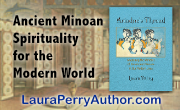
'...In All the Greater Temples'
Long ago, the Horned God was worshiped “in all the greater temples”, to use Gardner's pungent phrase.
(Well, maybe not all, but why pass up a snazzy quote like that?)
Then came the Great Forgetting. When he wasn't forgotten, he was reviled. Oh, our lives were the worse for it.
A few of us remembered, though. Always we missed him. In the consoling darkness, we whispered to one another prophecies of his Return.
Well, guess what, folks: the prophecies were true.
In a traditional society, now, remembering, we would make a lament for all those Lost Years.
Get Out Your Sieve
In terms of structure and realized characters, Goat Foot God (1936) is Dion Fortune's best novel: better, really, than either Sea Priestess or Moon Magic.
Which, of course, is not to say that it's a good novel, mind you. (As a friend once put it, “Dion Fortune couldn't write her way out of a chalk circle.”) But—unlike her turgid and (frankly) unreadable non-fiction—it has at least characters and a story to embody her ideas. The casual (and gratuitous) racism and unquestioned class prejudice of one who presumably regarded herself as enlightened should stand as a warning to the reader to judge her ideas on intrinsic merit, not on authority. Caveat lector.
Still, it's her novel about the Horned God and his Return. That you've got to love and, indeed, on that topic she has much to impart. As for the bugs in the flour...well, sift carefully. The sieve is a traditional witch's tool for a reason.
The Great God Pan she describes, in Christian idiom, as “God made manifest in Nature.” The novel tells two stories simultaneously: one of an early 20th century Englishman with a serious Vitamin P deficiency (talk about a pungent phrase), and a 15th-century English monk who rediscovers Pan via some Greek manuscripts.
Well, we need our stories from the Lost Years, too: so we remember “...or, failing that, invent” (Monique Wittig).
A Lament for the Horned
As epigraph to the book, Fortune cites four stanzas from her Rite of Pan. Rereading them recently, I found myself thinking: Well, there's our Lament for the Horned.
The Goat-Foot God















